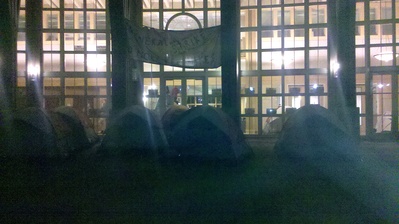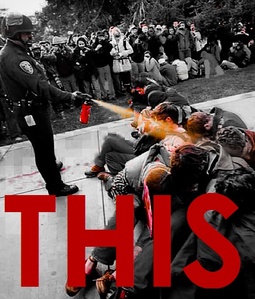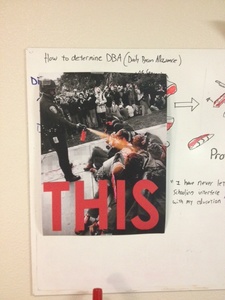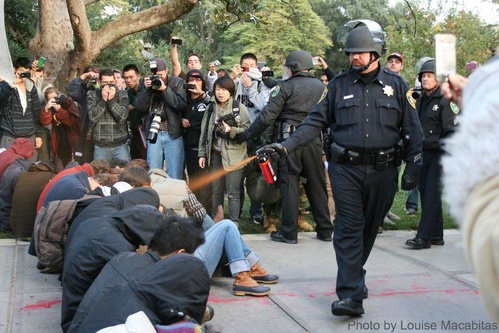 A police officer casually pepper-sprays peaceful, seated protesters, 18 November 2011. Photo by Louise Macabitas, used with permission.
A police officer casually pepper-sprays peaceful, seated protesters, 18 November 2011. Photo by Louise Macabitas, used with permission.
Major Events
In mid-November, a group consisting primarily of students began to gather on the UC Davis campus to protest tuition hikes, express solidarity with the Occupy movement, and to protest the November 10 police response to Occupy Cal, where protesters had been beaten with batons. This group, tentatively referred to as Occupy UC Davis, began with a November 15 rally. On November 17, tents were set up on the Quad, following the model of Occupy protesters around the nation. The protesters were informed that they were not permitted to stay on the Quad overnight, but camped out anyway. The events that occurred the next day between the protesters and the police put UC Davis under international scrutiny and provoked an immense reaction, both within the University community and in discussions around the world. One of the officers involved became a momentarily famous pop icon representing the abuse of authority, and the ramifications locally put campus law enforcement and the administration into a position of having to account for their decisions and actions, with a large outcry for the Chancellor to resign. You can more read about the findings of the official investigation of the pepper spray incident on the Reynoso report page.
UCD Police Pepper Spray Seated Protesters
On November 18, 2011, UC Davis Police were dispatched to the Quad to break up the Occupy UC Davis protest because some people were camping out in violation of university policy. That afternoon, the UC Davis Police Department called in mutual aid from Davis Police Department, UC Santa Cruz, UCSF, and UC Berkeley to help them evict the campers. This means that some of the officers who beat protesters with batons at Berkeley were present at Davis' protest of their behavior. Equipped in riot gear, they gathered on the quad and approached the protesters. At approximately 2:30 this video, which is the first of a 3-part series, it appears that a few tents remain set up in the center of the quad, with a line of protesters standing in a ring, arms linked, around the tents. At approximately 4:40 in the same video, a speaker announces that the police "will only use chemical weapons if you use force against them." It is unclear whether this information was represented to protesters by the police. At approximately 8:30 in the video, UC Davis Police Lt. John Pike addresses protesters through a loudspeaker.
Pike: "You have been advised that your actions constitute a violation of the law. You have been given several opportunities to voluntarily cease your actions and leave this area. This is your last warning. Should you choose to remain, you do so understanding that a peace officer shall place you under arrest for violation of the law. Any resistance, either passive or physical, shall result in additional charges. You shall be arrested, handcuffed, and maybe transported to and incarcerated at the Yolo County jail. Will you leave at this time? [Pauses for about 7 seconds] I say for the third time, section four-zero-nine of the Penal Code prohibits remaining present at an unlawful assembly. If you remain in the area which was just described, regardless of your purpose in remaining, you will be in violation of section 409. The following (?) routes of dispersal are available. You have been given 3 minutes to leave."
At around 11:00 in [the same video, police arrest a small number of protesters from the crowd; they do not appear to arrest anyone around the tents. A chant of "stop beating students" picks up at about 12:00 in the video, although, at least from this perspective, there is no sign of any students being beaten (but this video shows the arrests happening fairly violently. It has been stated previously that students and/or tents were struck with batons. By approximately 1:30 in the second video, about 16-1/2 minutes after the incident began, there were no more tents standing on the quad. At this point in the incident, there is a sizeable but widely dispersed crowd.
In the second video in the series, which picks up where the first left off, 15 minutes after police arrived, protesters begin to gather more densely. At approximately 4:30, there is something of a U-shaped mass of protesters. The area to the south, behind police from the camera's perspective, is clear of protesters. At around 6:20, large numbers of protesters begin moving. By 7:15 in the video, a thin ring of protesters goes most of the way around the officers, with the officers grouped around a small number of handcuffed protesters. A number of the officers look nervous at this point, holding their batons at the ready. At around 7:45 in the video, the protesters nearest the officers all sit down. By 8:00 in the video, the same officers who looked nervous appear much more relaxed.
At approximately 8:57 in the video, a man off-camera addresses the police, repeated by other protesters acting as a human microphone, stating, "if you let them go, we will let you leave. If you let them go, we will continue to protest peacefully." This has been interpreted by critics as a threat to the police.
At about 9:14 in the same video, an officer is seen leading one of the handcuffed protesters away. They pass off-camera and apparently pass through the protesters without camera. The police repeat this process with other arrested protesters, and at 10:00, someone near the camera comments that "they're taking them away one by one." At about this time, the camera shows one officer looking very on-edge, standing with a paintball-type gun half-raised with his finger on the trigger(note: from the angle of the video it appears as though he does not in fact have his finger ont he trigger and this is completely subject to opinion. And at 14:45 it appears that his finger is resting across the trigger not on the trigger itself.) A chant of "don't shoot them" begins at 10:35.
Throughout this period, police show a range of demeanors. Some officers have their visors lowered, covering their faces, others have them raised. At 13:22, an officer right in front of the cameraman seems quite relaxed, chewing gum and looking around impassively with his visor raised and his baton lowered. The officer next to him, on the other hand, has his feet spread, his visor lowered, and his baton held higher. At 13:35, two officers take away another cuffed protester, leaving without any difficulty.
A few minutes later, shortly after 3 pm, the UC Davis Police sprayed the seated non-violent protesters with chemical riot control agents. Photos (click here) and video (click here), now published by major media outlets around the world, clearly depict UC Davis Police Lt. John Pike pepper spraying protesters who are seated with their arms linked. Pike sprayed at close range, in the protesters' faces, using several spraying passes that ended up coating the protesters' faces with pepper spray. A second officer who has not been publicly identified (but see this article, which identifies him as Alexander Lee), seen in this video, joined in spraying the protesters. Under federal legal precedent, the use of pepper spray on nonviolent trespassing protesters violates their civil rights and constitutes excessive force.
The pepper spraying of peaceful students provoked intense emotional reactions around the world. Within 24 hours, there were public calls for the resignation of the UC Davis police chief and chancellor. Students, faculty, staff, and the public at large expressed their outrage, and thousands came out to support the protesters at subsequent events. Within a few days two separate inquiries began into what had actually occurred, and the university announced it would pay for the immediate medical bills of injured protesters.
Explanations and Immediate Aftermath
Initially, officials essentially claimed that the officers were defending themselves. UC Davis Police Chief Annette Spicuzza stated that the officers' safety was a concern. She told the Sacramento Bee that "There was no way out of that circle . . . They were cutting the officers off from their support. It's a very volatile situation." Video evidence proving otherwise quickly went viral. At approximately 2:10 in this video, for example, you see that Lt. Pike calmly and without any opposition stepped over the ring of protesters, exiting the circle. He then began spraying them in the faces a few seconds later. Critics of the protesters have viewed a statement from the protesters that "if you let [handcuffed protesters] go, we will let you leave" as a threat to the police, corroborating police safety concerns. This statement was made just under 10 minutes before Pike began spraying protesters. A counterpoint to the impression of this threat is that the seated protesters (specifically those who were subsequently sprayed) made no verbal or physical attempt to stop Officer Pike as he steps over and past them just before applying the spray.
The day after the pepper spraying, Chancellor Katehi interview told the L.A. Times, Katehi that she authorized police to remove the tents, but not to use the pepper spray in the manner shown on the video — "Absolutely not." At a news conference Saturday, UC Davis Police Chief Annette Spicuzza said the decision to use pepper spray was made at the scene. In this video, an unidentified officer can be seen talking on a cell phone and then apparently relaying a message to Officer Pike (3 minutes and 40 seconds into the video). A moment later, Pike walks up to a student named Kase, to warn him that he will soon be pepper-sprayed. This turn of events raises the strong possibility that the officers at the scene may have very well been following direct orders as opposed to coming up with the decision on their own. A portion of the conversation between Pike and Case is discernible in some of the videos of the incident and has been transcribed:
Pike: [Walks up to Kase. Speaks directly to him for about 8 seconds. Nearly inaudible on video.]
Kase: You're going to shoot me? You're going to shoot me for sitting here? Hey officer, is that what you said?
Pike: Yes.
Kase: Officer, is that ... [garbled audio]
Unidentified Male Protester: He just said yes.
Unidentified Female Protester: Shoot You. He's going to shoot you.
Kase: Alright. Just making sure. Just making sure.
Pike: [pats Kase on the back] I'm telling you right now.
Kase: You're shooting us for sitting here?
Pike: [garbled ]... That pepper spray gun... [garbled] [pats Kase on the back again and starts walking back to the rest of the police]
Kase: No, that's fine. That's fine. You're shooting us for sitting here.
On November 23 Katehi stated that she only told the campus police "to remove the tents or the equipment." She stresses that she told them "very specifically to do it peacefully, and if there were too many of them, not to do it, if the students were aggressive, not to do it. And then we told them we also do not want to have another Berkeley" (referring to the UC Berkeley protesters who were jabbed with nightsticks the week before, spurring the Occupy UC Davis movement).
Additional details emerged ten days after the initial incident when Linda Bisson, Chair of the Academic Senate, e-mailed UC Davis faculty. According to Bisson, Chancellor Katehi was meeting with the Executive Council of the Academic Senate at the time pepper spray was deployed against protesters. Katehi told the Executive Committee that she had asked for the tents to be removed and that this was happening as they were being told of her decision; there was no consultation with the Senate regarding this decision. Katehi assured the Executive Committee at that time that although the police had been told to remove the tents, she had clearly instructed them to do it peacefully and without force unless physically threatened or attacked (thus substantiating the claim that Katehi made on 11/23). Bisson stated that the Chancellor was seated next to her and that she did not receive any communication from the field. At some point during the meeting the chancellor was called to the hallway. She soon returned, and her report of what had happened was identical to the statement she subsequently made to the press. When Bisson asked the Chancellor the next day (Saturday) about that statement, the Chancellor said that she had repeated what she had been told by her staff concerning the events of the quad, and it was not until later that she saw video of the event herself.
The Silence Heard Round the World
One of the most powerful, memorable moments to spring from this incident evolved from a press conference scheduled by Chancellor Katehi and the campus Police Board for the afternoon of November 19. By 4:00 pm, the scheduled time for the press conference, some six hundred protesters had gathered at the campus television studio. The conference began as planned, but ended within about 15 minutes. Davis Patch reports that Ms. Katehi remained inside the building for two hours with police representatives, while members of the public were escorted out. Apparently, Ms. Katehi feared for her safety if she left the building. As detailed in this account, mediators spoke with Ms. Katehi and the protesters, and those gathered outside agreed to remain silent during Katehi's departure.
As seen in this video, at approximately 6:50 pm, almost three hours after the conference began, Katehi walked from Surge II to her waiting car through a stunning and remarkably moving silence. Following what has been called her walk of shame, Katehi responded to a reporter's question, saying that she would address students at the General Assembly planned for Monday. Police remained two blocks away during her departure.
November 21 Rally
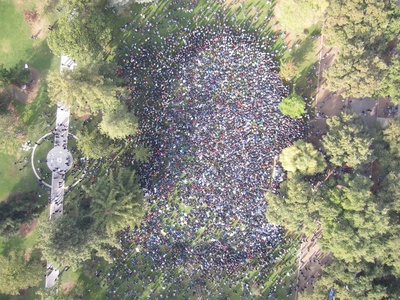 The rally from a helium balloon. Thanks to Stewart Long, Liz Barry, MicheleTobias, and Alex. Photo CC-By-SA Public Laboratory. On November 21, the Monday after the incident, an estimated 6,000 students, faculty, staff, and community members showed up for a rally on the Quad. Many speakers took the stage, including Ms. Katehi, who spoke for about two minutes. Choking up a bit, she pointed to a sign that said "November 17, 1973," telling the crowd that she remembered that day. It turns out that Katehi was present at a Greek university on that day when a revolt was violently put down. The event brought attention to her recent role in having the police return to Greek campuses.
The rally from a helium balloon. Thanks to Stewart Long, Liz Barry, MicheleTobias, and Alex. Photo CC-By-SA Public Laboratory. On November 21, the Monday after the incident, an estimated 6,000 students, faculty, staff, and community members showed up for a rally on the Quad. Many speakers took the stage, including Ms. Katehi, who spoke for about two minutes. Choking up a bit, she pointed to a sign that said "November 17, 1973," telling the crowd that she remembered that day. It turns out that Katehi was present at a Greek university on that day when a revolt was violently put down. The event brought attention to her recent role in having the police return to Greek campuses.
Following the rally, the university issued a press release announcing chief Spicuzza's placement on administrative leave. In the release Katehi also took "full responsibility for the events on Friday." It also stated that Katehi had called on the Yolo County District Attorney to investigate the use of force on protesters. The District Attorney agreed to conduct an investigation in conjunction with the county sheriff's department, but after a brief review of the issues they wrote a letter asking Attorney General Kamala Harris to take over the investigation; see this Vanguard article for more details.
- Video of the crowd from a helium balloon
- Summary of Rally by Jonathan Eisen
- Video Highlights Of Speakers And General Assembly 47 min
Continued Community Response
On 22 November 2011 there was a General Assembly on the Quad at 11 AM. There was also a Town Hall in Freeborn Hall from 5 PM until around 7:40 PM, open to all students, faculty and staff; a recording of part of the meeting is here. The Chancellor made opening remarks, followed by questions and comments from the community. UC Davis announced that the Chancellor has asked Acting UC Davis Police Chief Matt Carmichael to work with the Yolo County District Attorney’s Office to drop all criminal charges against the 10 individuals — nine of them students — who were arrested on November 18. Also, UC Davis has decided to pay immediate medical and emergency bills of students who were pepper-sprayed by police. A second Town Hall meeting for faculty and staff was held on November 29.
General Strike of November 28, 2011
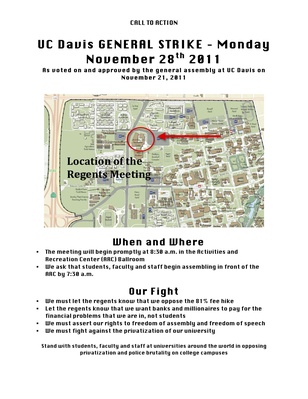
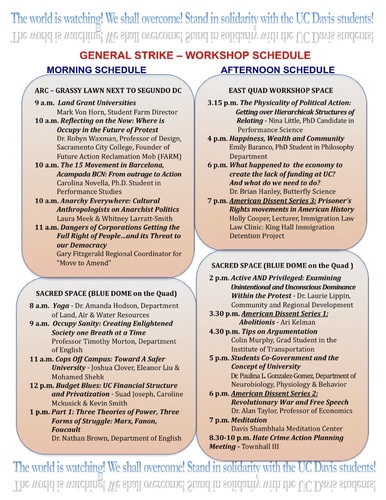 At the November 21, 2011 General Assembly there was a vote of 1729 for and about 30 against the motion for a General Strike for Monday, November 28. At least 56 other universities honored the strike. The San Jose Mercury News liveblogged the event; it is very detailed and covers events at the other participating UCs. Occupy California gives a briefer timeline.
At the November 21, 2011 General Assembly there was a vote of 1729 for and about 30 against the motion for a General Strike for Monday, November 28. At least 56 other universities honored the strike. The San Jose Mercury News liveblogged the event; it is very detailed and covers events at the other participating UCs. Occupy California gives a briefer timeline.
The Occupy UC Davis movement used cell phones to help coordinate actions; anyone could text Text "UCDACTION" to 23559 for updates on major strike actions.
The poster at the right identifies the ARC as the location of the Regents Meeting, and calls for students, faculty, and staff to begin assembling in front of the building by 7:30 AM. However, the Davis Enterprise reports: "Whether any appointed regents actually will be on campus remains up in the air... because their presence likely would prompt additional security... it’s up to each regent to choose which venue to attend." Indeed, the only Regents to attend were the student regents. The Enterprise article also notes: "People entering the ARC facility should expect metal-detecting security wands and possible pat-downs." If so, there's a question of why they would work to prevent violence when none has occurred — or even been threatened — by any students or Occupy supporters. It's a bit like patting down all attendees of a survivors of violence meeting.
Here is a rough timeline of the day's events: Public comment was taken in the ARC from 9-10 AM; video is here. The UC Office of the President insisted that a tuition increase was not on the agenda for the meeting, and indeed, it was not. Students began the day by unfurling a banner that read "Solidarity against the 81 percent fee increase" outside the ARC. By 8:50 AM, about 50 students were waiting to get into meeting. By noon, protesters had shut down the meetings at UCLA, UCSF, and UCD by making enough noise so that the meetings could not continue. Most protesters then proceeded to the Quad for a General Assembly, and then to the financial aid building, Dutton Hall. About 500 students occupied the building. A big banner over the front door read, "General strike, no more fee hikes." Nathan Brown conducted a teach-in inside. It should be noted that the Regents meeting reconvened, and despite claiming to be on the side of the students, they voted to raise several administrator salaries as much as 22%. Yudof and the Regents also continued to blame state disinvestment, rather than acknowledging legitimate concerns voiced during public comment about bloated administrative salaries, mismanagement of funds, investment of student fees in capital projects unrelated to academic instruction, fee hikes in excess of those necessary to compensate for state cuts, etc.
Teach-ins were held all day and continuing throughout the week — see schedule of teach-ins on this Google doc and flyer below. Please note that the flyer below does not include all scheduled workshops and the Google doc is much more comprehensive. Also, times and dates may be updated/changed, topics may be added, etc., so check back from time to time if you are interested.
- Video of Public Comments at UC Regents Meeting 90 min
- Video of Occupy UC Davis Occupying UC Regents Meeting 80 min
Concerns and Unanswered Questions
Concerning Chancellor Katehi's resignation
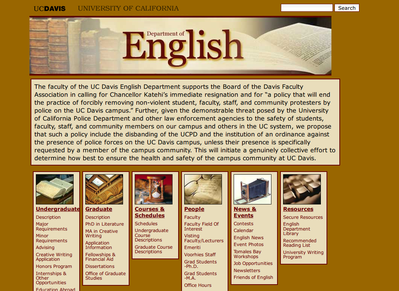 http://english.ucdavis.edu on the day of the rally, 2011-11-21.
http://english.ucdavis.edu on the day of the rally, 2011-11-21.
- There is currently an open letter by UCD associate professor Nathan Brown, calling for Katehi's resignation: "Your words express concern for the safety of our students. Your actions express no concern whatsoever for the safety of our students. I deduce from this discrepancy that you are not, in fact, concerned about the safety of our students. Your actions directly threaten the safety of our students. And I want you to know that this is clear." This open letter may inaccurately state that officers held mouths open, please see the Nathan Brown page for more information.
- An online petition calling for the resignation of Linda Katehi can be signed here. As of 8:30pm on 11/27/2011 over 100,000 people have signed. The content of the petition contains the open letter from Nathan Brown, above.
- Davis Faculty Association Board calls for Chancellor Katehi's resignation.
- An educator at Chinese College comments that brutality from UCD and UCB police in recent weeks is worse than the police state in China.
- The UCD Physics Department issues a press release 11/22 apologizing and asking for Chancellor Katehi's resignation.
- Viewpoints: UC Davis chancellor must do the right thing – resign — by David Buscho, one of the pepper-sprayed students.
- A large number of faculty signed a letter in support of Katehi. An analysis of the salaries of the signatories was done (all UC salaries are public information); the average was $151,111.50. Average for all UC Davis Professor salaries for 2010 is $138,838.09. Note that salaries vary a great deal by discipline, so the overall averages shown here can be misleading.
- A large number of faculty signed a letter saying that they have "no confidence" in Katehi. Anyone with spare time can calculate their average salaries, too.
- Various faculty letters condemning Katehi — including the Departments of Middle East/South Asia Studies, Comparative Literature, History, English, and Physics.
Rolling Heads or Paid Vacations?
On 20 November 2011 two of the officers involved in the incident were placed on paid administrative leave. The next day, campus police chief Annette Spicuzza joined the list of officers on a university-funded vacation (which is the first step toward firing police officers, though this usually precedes less serious sanctions or no sanctions at all). Katehi also said that she would have a task force of faculty, students, and staff convene immediately and give a recommendation in 30 days, rather than the 90 days she had specified the previous day.
Internal Investigation of the events of 18 November 2011
An internal investigation of the incident began while the officers were on paid administrative leave. According to an article in the Atlantic, state laws prohibit the resulting report from ever being read by the public, even though it would be the only report used to make the determination of which, if any, of the officers would be fired. The investigation was led by Ed McErlain and Deborah Maddux Allison, with extra assistance by Charles "Sid" Heal.
"Independent Investigation" of the events of 18 November 2011
As this investigation has absolutely no bearing on any possible disciplinary actions, its main purposes seem to be about creating the illusion of transparency in a process not accessible to the public, as well as to provide recommendations on how to avoid incidents in the future.
According to this Davis Vanguard article, the UC Davis Police Department has not been cooperating as fully with investigations as expected. After much negotiation, they agreed to allow police officers uninvolved in the pepper spraying to be interviewed.
Appointment of William Bratton to lead fact-finding effort
William Bratton, former Los Angeles Chief of Police, was appointed as an Independent Investigator by UC President Mark Yudof. However, many faculty have written letters objecting to Bratton's appointment, saying that his background shows that he endorses, implements, and promotes the very same militarized security policies responsible for the initial violent suppression of peaceful protesters last week. They are also concerned that this was a person picked by Yudof. In other words, they are concerned that this will not be a truly "independent" investigation. Instead, the investigator should be picked with input from members of the community (students, staff, and faculty) and should report to members of the community.
Here are some calls for a truly independent investigation:
- California Scholars for Academic Freedom — "We petition for an independent investigation of these actions to be conducted by faculty senate members and student representatives appointed by their own assemblies from the UC system free of administrative intervention or oversight."
- Reject appointment of Chief Bratton to review police brutality at UCD — A Change.org petition that anyone can sign; "we find powerful evidence indicating that Bratton endorses, implements, and promotes the very same militarized security policies responsible for the initial violent suppression of peaceful protesters last week."
Appointment of Cruz Reynoso to Lead Task Force
On November 28, 2011 President Mark Yudof announced that he was appointing former Justice of the California Supreme Court and UC Davis School of Law Professor Emeritus Cruz Reynoso to lead the task force investigating the events of November 18, 2011. Chief Bratton will still be doing a fact-finding investigation that will report to this task force.
The other members of the task force appointed by President Yudof are:
- Patrick Blacklock, Yolo County administrator and immediate past chair of the Cal Aggie Alumni Association;
- Peter Blando, business services manager, Office of the Vice Provost — Information and Educational Technology at UCD, and past chair of the UCD Staff Assembly (nominated by the UCD Staff Assembly);
- Alan Brownstein, professor in the UCD School of Law (nominated by the Academic Senate);
- Tatiana Bush, undergraduate student and former Associated Students of UCD senator (nominated by ASUCD);
- Daniel M. Dooley, senior vice president of external relations in UC’s Office of the President, designated systemwide administrator for whistleblower complaints, and a UCD alumnus;
- Penny Herbert, manager of the UCD department of clinical operations and staff adviser to the UC Board of Regents;
- Kathryn Kolesar, chair of the UCD Graduate Student Association (nominated by the GSA);
- William McKenna, UCD law student (nominated by the Law Students Association);
- Carolyn Penny, director of International Law Programs and principal and mediator of the Common Ground Center for Cooperative Solutions, UCD Extension (nominated by the UCD Academic Federation);
- Eric Rauchway, professor in the UCD history department (nominated by the Academic Senate);
- Judy Sakaki, vice president of student affairs in UC’s Office of the President and former vice chancellor for student affairs at UCD; and
- Rebecca Sterling, undergraduate student and former ASUCD senator (nominated by the ASUCD)
http://www.davisenterprise.com/local-news/ucd/yudof-names-members-of-task-force-headed-by-reynoso
Yolo County Investigation
The Yolo County District Attorney's and Sheriff's Offices are conducting a separate review of the incident. In a letter (here:LTRtoAG.pdf) dated Novemer 29, 2011 they request that the [Attorney General] conduct the investigation. The Attorney General's Office declined to do so on December 14, 2011. See response here:LTRfromAG.pdf. In the response, a reference to Governor Brown's request to review peace officer training material can be found here. The document referred is the 2003 Crowd Management and Civil Disobedience Guidelines, which provides a list of considerations for each agency to set their own protocol according to their jurisdiction.
Second officer?
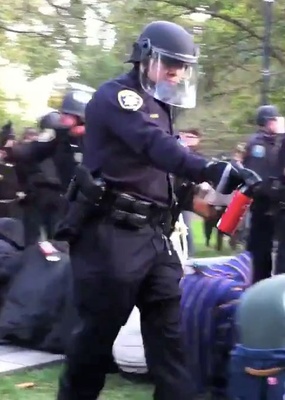 The second police officer who pepper sprayed non-violent protesters. He was supposedly suspended for his actions, along with John Pike. Can you identify this man?
The second police officer who pepper sprayed non-violent protesters. He was supposedly suspended for his actions, along with John Pike. Can you identify this man?
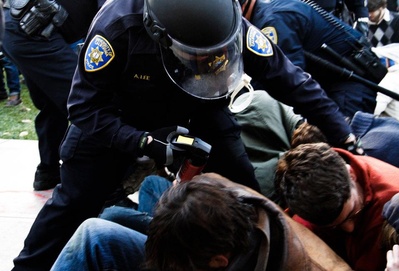 This photo clearly shows the second officer as being an "A. Lee." There is an Alexander P. Lee who works for the UCDPD as a "security guard" but that might not be a sworn position so it might not be the same person.
This photo clearly shows the second officer as being an "A. Lee." There is an Alexander P. Lee who works for the UCDPD as a "security guard" but that might not be a sworn position so it might not be the same person.
The Vanguard has identified the second officer as Alexander Lee.
Man in a Gray Suit?
Bisson's email to faculty also noted that many people had asked her about a man in a gray suit standing with the police and filming the crowd. Bisson said she asked the Chancellor about this man, but that the Chancellor told her that she does not know who that individual is nor why he was filming the crowd. One speculation is that he was monitoring the protest in order to have a record of who was there, as had been alleged with earlier protests. As revealed in the Reynoso report, this man is Ben McNulty, a non-sworn analyst who works for the UC Davis Police Department.
- This guy's name is McNulty I think, he's a security guard or Aggie Host or something. - ReallyAdamSmith
 Do you know who this person is or why he was there?
Do you know who this person is or why he was there? 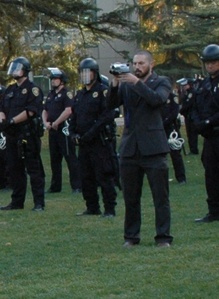
Resources
Video
Complete trilogy depicting the event from the time the police enter the Quad to the time the police leave the Quad, from user "jhweather":
Another trilogy apparently exists from the perspective of a different student. However, YouTube user "harrisnaemi" has only posted the latter two parts.
Second video from "libbacoop" - shows police confrontations but not pepper spray
Video from YouTube user "asucd", the account for AggieTV
Video from YouTube user "jamiehall1615" (especially good angle)
Video from YouTube user "meggeyhead" (another good angle, pepper spray starts around 2:10)
Compilation by YouTube user "waxpancake" of time-synced videos from briocloud, jamiehall1615, OperationLeakS and asucd
Video from YouTube user "robroy" (a collection of incident photos and pepper spray meme images alng with audio of a Lady Gaga "Poker Face" parody entitled "Pepper Spray")
Video of Town Hall Meeting — with Chancellor Katehi and others, 22 November 2011.
My Fees are Hella High — One UCD student's attempt to refocus on the real issues
Video from YouTube user "Timasu" — Presents a case defending police action.
Another video from YouTube user "Timasu" — with commentary removed, for those who prefer to watch a video without biased arguments the whole time.
Photos
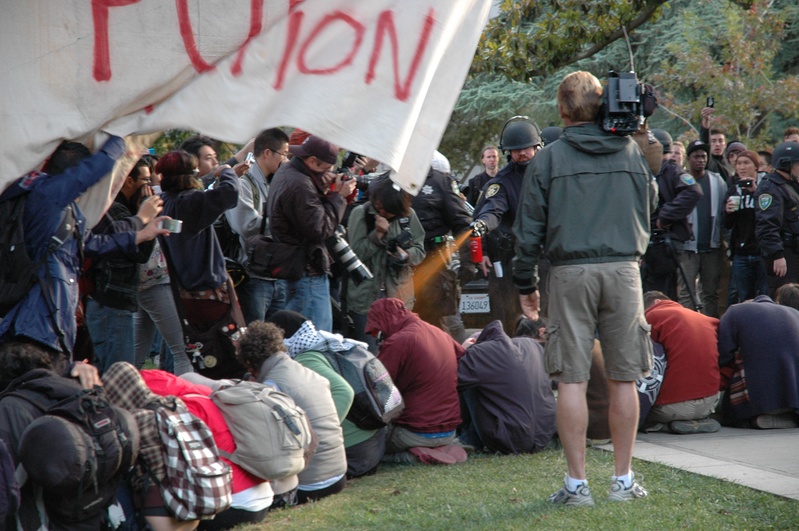
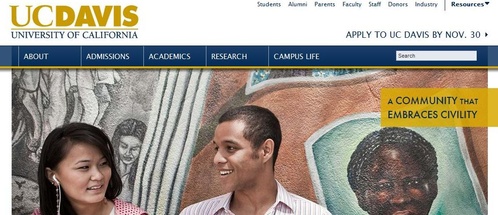 UC Davis' web page shortly after the incident. If this is civility, I'd hate to see what happens when this community loses its cool.
UC Davis' web page shortly after the incident. If this is civility, I'd hate to see what happens when this community loses its cool. 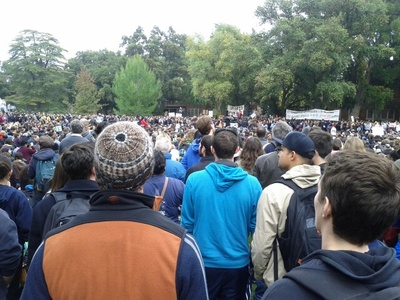 Just a portion of the crowd at the noon rally on the quad, 21 November 2011.
Just a portion of the crowd at the noon rally on the quad, 21 November 2011. 
Poster
This image was distributed as a poster prior to the November 21 rally. It is freely available to replicate and modify, and you can contact its creator for a blank version. An 18" x 24" color print is $23 at Kinko's; black and white is much cheaper. UCD Reprographics might also be cheaper.
Personal accounts
- A student who was protesting with the group's experience
- A timeline of how the news spread on twitter and how the national and international media started to pick up on the story
- Prof. Jonathan Eisen from UC Davis on the day of the spraying
- Prof. Jonathan Eisen from UC Davis on the "Press Conference" and the protests outside
- Kristin Stoneking on escorting Katehi out of Surge II
- "They Told Me They Were Gonna Shoot Us" Kase Wheatley Pepper Sprayed UC Davis Protester — video of interview
- Video interview with Willee, a student protester
- ALCU video interview with Sarena Grossjan, Fatima Sbeih, and David Buscho
Full Text Letters
The full text of a number of letters on this issue, including Chancellor Katehi's letters, letters from the Academic Senate, and letters from the Graduate Student Association can be found here.
The Chancellor's office also produced a "Fact Sheet on Recent Demonstrations at UC Davis", giving answers to the following questions: What happened? What investigations are being conducted? Who oversees the UC Davis Police Department? What is UC Davis' policy with regard to protecting Free Speech? There are five investigations listed: a. Comprehensive investigation By UC Davis, b. Yolo County District Attorney’s Office and Yolo County Sheriff’s Department Review, c. UC Office of the President-Led Task Force, d. UC Office of the President Systemwide Review of all Campus Police Policies, e. UC Davis Academic Senate Review
- It is important to note that the above piece of university propaganda does not actually answer the questions of what happened and twists many facts. For example:
- When they closed Mrak Hall on Wednesday, November 16, there were riot cops standing by. This building actually remains on lockdown and even those with appointments have trouble getting into the building.
- Obtaining a reservation or permit for use of the Quad kind of defeats the purpose of civil DISobedience.
- Their portrayal of UC Berkeley and UCLA police dismantling of encampments in 'generally peaceful fashion' COMPLETELY ignores the beating of students and faculty by UCPD at Berkeley the week prior.
- Investigation A, supposedly an "independent" fact-finding investigation, is being spearheaded by Vice Chancellor John Meyer, who is in fact the person the campus police chief reports to!
- Starting with the first Town Hall meeting, the chancellor has claimed that she has no authority whatsoever over the police. This is inconsistent with her claim that she specifically ordered 'no arrests and no use of force' (as an aside, it is quite interesting that it took her several days to share this tidbit with the public- why wasn't this the first sentence of her first letter after the attack? She allegedly told this to the chair of the academic senate as the raid was underway). Further, as she is directly above John Meyer, the vice chancellor who supposedly oversees police operations, there appears to be a direct chain of command.
- They continue to insinuate that camping on the quad "unduly infringes on the rights and freedoms of others," when anyone is welcome to join the camp or use the remaining 80% of the Quad.
- Some faculty have endorsed this annotated fact sheet; the annotations were "inspired by George Orwell's 1946 essay Politics and the English Language which analyzes the ways in which language can be used to deflect responsibility."
On December 9th, an article under Linda Katehi's byline appeared in the Huffington Post. Titled Our Students Are Not Protesting in a Vacuum, it laid out her view of the situation, and what she had done to address the situation and the underlying complaints of Occupy UC Davis. The comments under the article were quite negative.
Media Coverage
 CNN.com Front Page, 19 November 2011
CNN.com Front Page, 19 November 2011  The pepper-spraying of peaceful protesters was the top story on Google News, 19 November 2011
The pepper-spraying of peaceful protesters was the top story on Google News, 19 November 2011 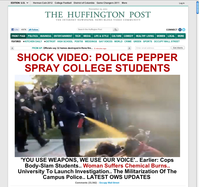 Huffington Post Front Page, 19 November 2011
Huffington Post Front Page, 19 November 2011
November 18
- UCD Police remove Occupy UC Davis tents — The Davis Enterprise (Ongoing coverage)
- Protestors Face Off With UC Davis Campus Police — The California Aggie
- 10 Occupy Protestors Arrested At UC Davis Quad — The Sacramento Bee
- Students Arrested & Pepper Sprayed at Occupy UC Davis Camp (VIDEOS) — Davis Patch
- Police pepper-spraying, arresting peacefully seated students at UC Davis —BoingBoing
- Police Pepper Spray, Arrest Demonstrators in Davis — Fox40
- UC Davis Officers Suspended After Friday's Pepper Spray Incident
November 19
- One day after pepper-spraying, UC Davis students silently, peacefully confront Chancellor Katehi — BoingBoing
- U.C. Davis Calls for Investigation After Pepper Spraying — The New York Times Lede Blog
- UC Davis Police Pepper-Spray Seated Students In Occupy Dispute — The Huffington Post (Updated 11/20)
- Video shows Occupy protesters pepper sprayed at UC Davis — Los Angeles Times
- Video shows pepper spraying of UC Davis protesters — CBS News
- Video Shows Pepper Spraying of UC Davis Protesters — ABC News
- Video shows office pepper-spraying protesters at UC Davis — New York Daily News (updated 11/20)
- The moment police pepper-spray peaceful Occupy protesters at University of California — Canada National Post
- UC Davis Police Brutally Pepper Spray OWS Protesters Sitting Peacefully on Campus — Cleveland Leader
- Video spreads of UC Davis cops pepper spraying Occupy students — MSNBC.com (Video removed due to copyright claim)
- Occupy Maced: Police pepper spray unarmed youth, tear tents down - Russia Today News
- Police Spray Seated Occupy Protestors — CNN
- Police Should Criticize, Not Defend, Excessive Use of Force at UC Davis — Forbes.com
November 20
- Pepper spray: US campus police suspended — BBC News
- California University Puts Officers Who Used Pepper Spray On Leave — New York Times (subscription required)
- US university investigates campus pepper spray use — BBC
- UC Davis police placed on leave after pepper spray video outrage | World news | guardian.co.uk
November 21
- US University Probes Protest Pepper Spray — Al Jazeera
- UC-Davis Chancellor Linda Katehi Denies Resignation, Says the 'University Needs Me' — ABC's "Good Morning America", interview with Chancellor Katehi
- Occupy UCD calls for General Strike — Occupy Wall Street
- DA and Sheriff Refer Pepper Spraying Matter to Attorney General
November 22
- Image as interest: How the Pepper Spray Cop could change the trajectory of Occupy Wall Street — Analysis of the (now famous) photos of John Pike at Harvard's Nieman Lab]
Timeline
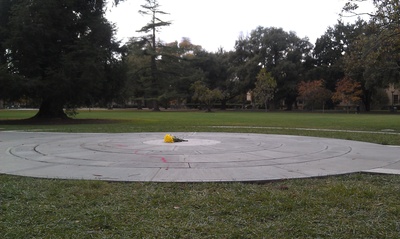 Flowers on the Quad on 2011-11-20. Photo by Suzanne Phan, used with permission. The following is a timeline of events. When an article relays an open letter, the date of the letter (not the date of the article) is used if it is stated.
Flowers on the Quad on 2011-11-20. Photo by Suzanne Phan, used with permission. The following is a timeline of events. When an article relays an open letter, the date of the letter (not the date of the article) is used if it is stated.
2011
- Nov 9: UC cops' use of batons on Occupy camp questioned - The UCD protest was partially in solidarity with what happened at Berkeley
- Nov 15: UC Berkeley Police shot gun-wielding man on Cal campus
- Nov 16: Mrak demonstrators kicked out
- Nov 16: Katehi gave OK for protesters to stay overnight on the Quad. (Where is the actual letter of this agreement?)
- Nov 18: Chancellor’s message to protesters on the Quad asking for the tents to be removed by 3pm.
- Nov 18: The Pepper Spray Incident
- Nov 18: UC Davis Chancellor Linda Katehi has written a letter (full text here) stating her view that the encampment was a health and safety threat. The letter does not specify the nature of this threat. In addition, it seems strange that her main concern was removing the tents (considering how much she claims to support freedom of speech), since the riot police maced protesters AFTER the tents were no longer in the area.
- Nov 19: Sacbee: Police Chief Spicuzza defends use of pepper spray.
- Nov 19: An online petition calling for the California Attorney General to arrest Lt. John Pike can be signed here. Alternatively, you can also contact Yolo DA Jeff Reisig at http://www.jeffreisig.com to make sure this kind of criminal behavior is not tolerated.
- Nov 19: UC Davis Professor Bob Ostertag has written about the militarization of police forces. A broader examination of the system of militarized responses to protests provocatively starts with "feeling bad" for John Pike.
- Nov 19: Professor Nathan Brown set up an Amazon Wishlist where people can buy tents, presumably for the Occupy UC Davis movement.
- Nov 20: Arthur Shapiro, UCD Distinguished Professor letter to Linda Katehi can be found here.
- Nov 20: Letter from UCD Professor Artyom Kopp
- Nov 20: Peter J. Richerson, professor emeritus, in an open letter to Katehi
- Nov 20: Cynthia Ching wrote an open letter apologizing to the students on behalf of the faculty for letting administrators and not teachers run the campus.
- Nov 20: Faculty and staff of the Linguistics Department and Graduate Group
- Nov 21: Why I'm not visiting UC Davis in April by NYU Professor Alexander R. Galloway
- Nov 21: A response from UCD Physics Professor Jim Crutchfield.
- Nov 21: San Diego Police
- Nov 21: Letter from Women and Gender Studies Dept. (Content: 11/20, Pub. 11/21, )
- Nov 21: UC Davis School of Law (Published 11/21)
- Nov 22 AM: Letter from Prof. Mau Stanton (Pub. 11/22 AM)
- Nov 22 PM: Reporting from the Town Hall meeting (with video) (11/22 PM) Katehi: "I explicitly directed the chief of police that violence should be avoided at all costs. It was the absolute last thing I ever wanted to happen. [...] My instructions were for no arrests and no police force."
- Nov 23: Support for Campus PD and use of pepper spray coming from the Davis College Republicans.
- Nov 23: Should UC Davis Faculty Walkout on Monday
- Nov 23: Federated University Police Officers Association: Use of pepper spray was included in plan of upper police management - Dieter Dammeier, an Upland lawyer for the Federated University Police Officers Association, the union that represents UC Davis officers, said the operations plan issued by the department includes the use of pepper spray. The article says nothing about the circumstances under which the pepper spray is supposed to be used, so it gives no new information. According to the article, the lawyer also claimed that the officers were doing simply what they were instructed to do by police management.
- Nov 28: Linda Bisson statement. (See context)
- Nov 28 Nov28 General Strike, 11-28 UC Berkeley police department has an open letter to UC Regents: "Please don't ask us to enforce your policies then refuse to stand by us when we do. Your students, your faculty and your police — we need you to provide real leadership."
- Nov 29: Nov29 Town Hall meeting with Faculty and Staff
2012
- Dec 9: Our Students Are Not Protesting in a Vacuum — An article in the Huffington Post by Linda Katehi
- Dec 10: Katehi, chief huddled with 13 on decision to remove camp: UCD released 13 names of the emergency team that decided to remove the tents.
- Dec 14: Sacbee: Katehi confronted by pepper-spray victim at Capitol
- Dec 21: Bob Ostertag reports the story of a pepper-sprayed student's attempt to talk with Katehi
- Jan 8: Reynoso takes control of investigation
- Jan 12: Deploying riot police, UC? Little Brother is watching
- Jan 20: Reynoso (pdf): Report expected by Feb 21.
- Feb 1: UC Davis uploaded a PDF about its view on the rights and responsibilities regarding peaceful protest
- Feb 7: UC Davis forms Emergency and Crisis Management Team and discloses its structure
- Feb 16: Pepper spray report delayed again
- Feb 17: UC Davis faculty rejects no-confidence vote on chancellor
- Feb 22: students and alumni file federal lawsuit against UC Davis
- Mar 1: Provost Hexter sent an email to invite the UC Davis community for a public forum on March 6th to unveil the Reynoso report.
- Mar 2: Reynoso report to be released at noon on March 6, followed by a campus meeting at 3-4:30 p.m. in the university's Conference Center Ballroom
- Mar 5: Task force holds findings due to union legal action. (LA Times Link, Official University of California announcement).
- Mar 6: John Pike, along with the police union, files a lawsuit in Alameda County Superior Court (John Pike vs. University of California Board of Regents, RG12619930) asking for the court to block the release of the Kroll/Reynoso report. Pike's argument is that the report violates his right to privacy and that portions of the report constitute police personnel records which are confidential under California's Police Officers' Bill of Rights (POBOR).
- Mar 28: Judge Grillo rejects the argument that the Kroll/Reynoso report constitutes confidential police personnel records and rules that the UC can release the entire report. All officer names and ranks aside from those of Pike and Spicuzza are to be redacted for officer safety. Alexander Lee and the other police officers named in the report are to be given pseudonyms in the interim. When the case goes to trial, a final decision will be made about the release of the names. The order has been stayed until April 23, 2012 to allow for appeals.
- Apr 9: The task force today tentatively scheduled public release of its report and recommendations after attorneys for UC and the police union jointly asked an Alameda County Superior Court judge to lift a stay he had imposed. Pending the judge’s ruling after a hearing scheduled for Tuesday, April 10, the task force now plans to outline its findings and recommendations to the UC Davis community – students, faculty and staff – on Wednesday, April 11, from 3:30 to 4:45 p.m. in Freeborn Hall at UC Davis. See press release. Various news outlets state that the report will not include officers' names other than Spicuzza and Pike. According to the Davis Enterprise,
- "In its latest request to the judge, filed Friday, UC says it will agree indefinitely not to release the reports without first replacing the names with pseudonyms and ranks of police with the generic title “officer.” In return, the union has agreed not to file an appeal."
- "Another party to the lawsuit, the American Civil Liberties Union of Northern California, was on Monday afternoon still “making sure we’re all on the exact same page,” staff attorney Michael Risher said. The ACLU will not stand in the way of the settlement if the agreement makes clear that officer names can still be obtained by others under the public records act, he said."
- Apr 11: The task force issues its conclusions, called the Reynoso report.
- Apr 18: Spicuzza resigns as Chief of the UCDPD, saying, ""As the university does not want this incident to be its defining moment, nor do I wish for it to be mine. I believe in order to start the healing process, this chapter of my life must be closed."
- Apr 19: Matt Carmichael was appointed as Chief of the UCDPD for one year. According to the SF Chronicle, "Carmichael was not on campus when the confrontation occurred. He was working in Sacramento at the UC Davis Medical Center."
- May 1: The Executive Council of the Davis Division of the Academic Senate voted to censure Chancellor Linda P. B. Katehi for "failure to perform adequately the tasks of her office and failure to provide clarity, candor, and trustworthy accounts in relation to the events of November 18, 2011.". The Special Committee voted in favor of her resignation; the Executive Council did not endorse that vote (although the Davis Faculty Association did), but it endorsed other recommendations of the Special Committee. The complete record of recommendations is here.
- June 26: Alameda Superior Court Judge Evelio Grillo ordered the previously redacted names of the officers in the Reynoso report to be released to the public. The order is stayed through July 27 however, pending appeal by the police union. The Vanguard (who relied on information and a photo from the Davis Wiki) having published some of those names already was instrumental in the ruling.
- Sept 13: The Robinson-Edley Report was released. Link here.
- Sept 26: UC Regents agree to pay ONE MILLION DOLLARS in compensation to the victims of the pepper spray and their lawyers in a settlement. Each student is set to receive an apology letter from Linda Katehi as well.
2013
- Former officer John Pike is awarded $38,055 in worker's compensation, claiming "psychiatric injury specific or due to continuous trauma from applicant's employment at UC Davis".
2014
- Sacramento Bee obtains and shares the unredacted version of the Kroll and Reynoso reports. You can download it here: Reynoso and Kroll report unredacted.pdf
- The animated television series American Dad wraps the episode "Big Stan on Campus" around a very similar series of events when the titular character is furloughed and takes a job as a campus security officer.
Other websites
- UCD Police remove Occupy UC Davis tents — The Davis Enterprise (Ongoing coverage)
- Dateline: Investigation Reports status.
- Ten things you should know about Friday's UC Davis Police Violence — Student Activism
- Humorous Amazon.com reviews of the pepper spray that Lt Pike used
- "...Congress will vote on explicitly creating a police state." — Davis mentioned.
Make a Comment
Discussion has been moved to November 18, 2011 UC Davis Police Response to Occupy UC Davis/Discussion. Please join in if you wish.


